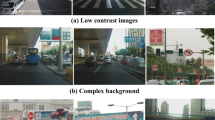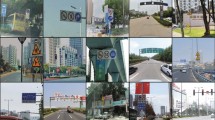Abstract
Co-saliency detection aims at finding the salient regions from multiple images which capture the focus of human visual system. In this paper, a novel visual co-saliency algorithm is proposed, which adopts three human visual attention cues: contrast, center-bias and symmetry. In order to apply co-saliency to the detection of traffic signs, a traffic sign detection framework based on visual co-saliency in complex scenes is devised. The detection process involves two stages. In the first stage, a cluster-based co-saliency model is built to generate the final co-saliency map. In the second stage, a geometric structure constraint model is constructed to discriminate the detected salient objects and then accurately achieve location of traffic signs. The advantage of our approach lies in the integration of bottom-up and top-down visual processing, and no heavy learning tasks. Experiments on a variety of benchmark databases illustrate high precision, high recall and operation efficiency of the proposed approach. Besides, for traffic sign detection it overcomes the interference of complex urbanization backgrounds. Furthermore, the best trade-off between precision and recall on warning signs is achieved, reaching 93.30% and 89.06%, respectively.


























Similar content being viewed by others
References
Zhang Q (2016) The design of salient object detection experiment based on visual attention. Research & Exploration in Laboratory
Ramk DM, Sabourin C, Moreno R, Madani K (2014) A machine learning based intelligent vision system for autonomous object detection and recognition. Appl Intell 40(2):358–375
Goferman S, Zelnik-Manor L, Tal A (2012) Context-aware saliency detection. IEEE Trans Pattern Anal Mach Intell 34(10): 1915–1926
Fang Y, Lin W, Sung Lee BS, Lau CT, Chen Z, Lin CW (2012) Bottom-up saliency detection model based on human visual sensitivity and amplitude spectrum. IEEE Trans Multimed 14(1):187–198
Toet A (2011) Computational versus psychophysical bottom-up image saliency: a comparative evaluation study. IEEE Trans Pattern Anal Mach Intell 33(11):2131
Yang MH, Yang J (2012) Top-down visual saliency via joint crf and dictionary learning. In: IEEE conference on computer vision and pattern recognition, pp 2296–2303
Xu Y, Li J, Chen J, Shen G, Gao Y (2017) A novel approach for visual saliency detection and segmentation based on objectness and top-down attention. In: International conference on image, vision and computing, pp 361–365
Borji A, Cheng M-M, Jiang H, Li J (2015) Salient object detection: a benchmark. IEEE Trans Image Process 24(12):5706– 5722
Arya R, Singh N, Agrawal RK (2017) A novel combination of second-order statistical features and segmentation using multi-layer superpixels for salient object detection. Appl Intell 46(2):1–18
Jiang H, Wang J, Yuan Z, Wu Y (2013) Salient object detection: a discriminative regional feature integration approach. In: Computer vision and pattern recognition, pp 2083–2090
Itti Laurent, Koch Christof, Niebur Ernst (1998) A model of saliency-based visual attention for rapid scene analysis. IEEE Trans 20(11):1254–1259
Achanta R, Estrada F, Wils P, Süsstrunk S (2008) Salient region detection and segmentation. Springer, Berlin
Cheng MM, Mitra NJ, Huang X, Torr PH, Hu SM (2015) Global contrast based salient region detection. IEEE Trans Pattern Anal Mach Intell 37(3):569
Hou X, Zhang L (2007) Saliency detection: a spectral residual approach. In: IEEE conference on computer vision and pattern recognition, 2007. CVPR ’07, pp 1–8
Jacobs DE, Goldman Dan B, Shechtman E (2010) Cosaliency:where people look when comparing images. In: ACM symposium on user interface software and technology. New York, pp 219–228
Cao X, Tao Z, Zhang B, Fu H, Feng W (2014) Self-adaptively weighted co-saliency detection via rank constraint. IEEE Trans Image Process: A Publ IEEE Signal Process Soc 23(9): 4175–4186
Li H, Meng F, Ngan KN (2013) Co-salient object detection from multiple images. IEEE Trans Multimed 15(8):1896–1909
Chang KY, Liu TL, Lai SH (2011) From co-saliency to co-segmentation an efficient and fully unsupervised energy minimization model. In: IEEE conference on computer vision and pattern recognition, pp 2129–2136
Li H, Ngan KN (2011) A co-saliency model of image pairs. IEEE Trans Image Process: A Publ IEEE Signal Process Soc 20(12):3365
Chen HT (2010) Preattentive co-saliency detection. In: IEEE international conference on image processing, pp 1117–1120
Fu H, Cao X, Tu Z (2013) Cluster-based co-saliency detection. IEEE Trans Image Process: A Publ IEEE Signal Process Soc 22(10):3766
Liu Z, Zou W, Li L, Shen L, Meur OL (2013) Co-saliency detection based on hierarchical segmentation. Process Lett 21(1):88–92
Hu X, Zhu X, Li D (2012) Traffic sign detection based on biologically visual mechanism. ISPRS - International Archives of the Photogrammetry. Remote sensing and spatial information sciences, XXXIX-B3, pp 217–221
Mogelmose A, Trivedi MM, Moeslund TB (2012) Vision-based traffic sign detection and analysis for intelligent driver assistance systems: perspectives and survey. IEEE Trans Intell Transp Syst 13(4):1484–1497
Guo H, Liu H, Bi S (2011) Detection of traffic signs based on visual saliency model. In: International conference on multimedia technology, pp 3035–3038
Gudigar A, Chokkadi S, Raghavendra U (2016) A review on automatic detection and recognition of traffic sign. Multimed Tools Appl 75(1):333–364
Greenhalgh J, Mirmehdi M (2012) Real-time detection and recognition of road traffic signs. IEEE Trans Intell Transp Syst 13(4):1498–1506
Romdhane NB, Mliki H, Hammami M (2016) An improved traffic signs recognition and tracking method for driver assistance system. In: Ieee/acis international conference on computer and information science, pp 1–6
Prisacariu VA, Timofte R, Zimmermann K, Reid I, Gool LV (2010) Integrating object detection with 3d tracking towards a better driver assistance system. In: International conference on pattern recognition, pp 3344–3347
Zang D, Zhang J, Zhang D, Bao M, Cheng J, Tang K (2016) Traffic sign detection based on cascaded convolutional neural networks. In: Ieee/acis international conference on software engineering, artificial intelligence, NETWORKING and parallel/distributed computing, pp 201–206
Shi JH, Lin HY (2017) A vision system for traffic sign detection and recognition. In: IEEE international symposium on industrial electronics, pp 1596–1601
Achanta R, Hemami S, Estrada F, Susstrunk S (2009) Frequency-tuned salient region detection. In: IEEE conference on computer vision and pattern recognition, 2009. CVPR 2009, pp 1597–1604
Duan L, Wu C, Miao J, Qing L (2011) Visual saliency detection by spatially weighted dissimilarity. In: Computer vision and pattern recognition, pp 473–480
Tatler BW (2007) The central fixation bias in scene viewing: selecting an optimal viewing position independently of motor biases and image feature distributions. J Vis 7(14):4.1
Rothkegel LOM, Trukenbrod HA, Schtt HH, Wichmann FA, Engbert R (2017) Temporal evolution of the central fixation bias in scene viewing. J Vis 17(13):3
Widynski N, Moevus A, Mignotte M (2014) Local symmetry detection in natural images using a particle filtering approach. IEEE Trans Image Process 23(12):5309–22
Kovesi P (2000) Phase congruency: a low-level image invariant. Psychol Res 64(2):136
Liu T, Yuan Z, Sun J, Wang J, Zheng N, Tang X, Shum HY (2011) Learning to detect a salient object. IEEE Trans Pattern Anal Mach Intell 33(2):353
Lang C, Nguyen TV, Katti H, Yadati K, Kankanhalli M, Yan S (2012) Depth matters: influence of depth cues on visual saliency. In: European conference on computer vision, pp 101–115
Batra D, Kowdle A, Parikh D, Luo J (2010) icoseg:interactive co-segmentation with intelligent scribble guidance. In: Computer vision and pattern recognition, pp 3169–3176
Larsson F, Felsberg M (2011) Using fourier descriptors and spatial models for traffic sign recognition. In: Scandinavian conference on image analysis, pp 238–249
Wei W, Yang XL, Zhou B, Feng J, Shen PY (2012) Combined energy minimization for image reconstruction from few views. Math Probl Eng,2012,(2012-10-31) 2012(3):1094–1099
Wei W, Fan X, Song H, Wang H (2017) Video tamper detection based on multi-scale mutual information. Multimed Tools Appl 2017(9):1–18
Wei W, Qi Y (2011) Information potential fields navigation in wireless ad-hoc sensor networks. Sensors 11 (5):4794–4807
Lowe DG (2004) Distinctive image features from scale-invariant keypoints. Int J Comput Vis 60(2):91–110
Acknowledgements
This research was funded by State Key Laboratory of Mechanical Transmissions of Chongqing University (SKLMT-KFKT-201602), State Key Laboratory of Robotics and System (HIT)(SKLRS-2017-KF-13), Major Projects of Science and Technology in Hunan (Grant No.2017GK1010), National Key Research and Development Plan (Grant No. 2018YFB1201602), National Natural Science Foundation of China (Grant No.61403426), Fundamental Research Funds for the Central Universities of Central South University (Grant No.2017zzts490) and National Natural Science Foundation of Hunan (Grant No.2018JJ2531, 2018JJ2197).
Author information
Authors and Affiliations
Corresponding authors
Rights and permissions
About this article
Cite this article
Yu, L., Xia, X. & Zhou, K. Traffic sign detection based on visual co-saliency in complex scenes. Appl Intell 49, 764–790 (2019). https://doi.org/10.1007/s10489-018-1298-8
Published:
Issue Date:
DOI: https://doi.org/10.1007/s10489-018-1298-8




